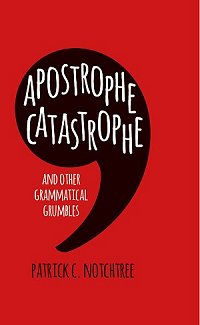|
Apostrophe Gallery
your apostrophe stories and photos |
| ||
Avoid an "Apostrophe Catastrophe" with the little red book. |
Latest addition |

|
| Given that this meant to refer to multiple Sundays around Christmas, it should simply be a plural. No apostrophe. |

|
|
Patrick C Notchtree
Author of "The Clouds Still Hang" |

|
|
Now out, the book of the website, 'Apostrophe Catastrophe', published by The History Press
AmazonUSA | AmazonUK |
The apostrophe must be the most misunderstood and misused piece of punctuation in the language. This is made worse by the fact that most people simply fail to understand what it does, and make it unnecessarily complicated. The result is that many people, in an effort to appear correct, use a scattergun approach, dropping in apostrophes every time the letter "s" ends a word, for plurals, possessives and contractions alike.
In fact, using the apostrophe correctly is easy - once you know the rule!
Notice I say, "the rule". Despite the confusion about this and many variations, there is in fact just one place where an apostrophe is used. Just one. It really is easy to remember.
I have taught many children, mainly Year 6 (aged 10-11), this method over many years and 90% of them have "got it" immediately and never get it wrong again. Sadly the other 10% would probably never "get it", at that age anyway.
Explaining something in written form is not the same as interactive teaching, where the listeners respond and the teacher can adapt as they go along. I have tried to take this step by step and cover all the angles, but it means there is a lot of reading to do. Please be patient.
You may well be thinking, "How can this be so?" But it's true, there is just a single rule.
The reason for this goes back to the Germanic roots of the English language where case endings ruled the day. They survive in modern German but have almost disappeared in modern English.

Those of you who were taught a multi-rule method (presumably unsuccessfully or why would you be here) are probably now puzzled. How can there be just one rule which covers all uses of the dreaded apostrophe? I repeat:
Misuse often occurs where plurals are involved. Plural simply means more than one. So we see the famous greengrocer signs like Carrot's cheap today. But there is nothing missing here, it just means more than one carrot, so it should read Carrots cheap today. Another example: Parent's are asked to supervise their children. Again nothing is missing, it is a request to more than one parent to look after their kids. The correct form is Parents are asked to supervise their children. But the children belong to the parents, you say. True no doubt, but the two words are not together in the sentence and the message is directed at parents, not children. Parents children would need an apostrophe, but before or after the "s"? Have no fear, the answer is at hand.
Home | Do you know? | Self Test | The little red book | Testimonials | Gallery Quiz| Links
| The URL of this site is http://www.dreaded-apostrophe.com |